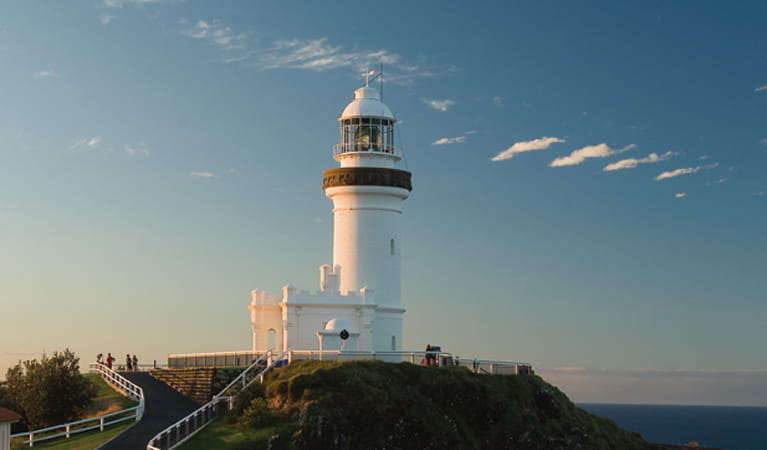Cape Byron Lighthouse
Cape Byron State Conservation Area
Overview
Cape Byron Lighthouse sits on Australia’s most easterly point, a shining light over Byron Bay. Find out about shipwrecks, enjoy spectacular views or call ahead to join a guided tour.
- Type
- Historic buildings/places
- Accessibility
- No wheelchair access
- Entry fees
-
Park entry fees apply at the Cape Byron Lighthouse carpark.
- What to
bring - Binoculars, hat, sunscreen
- Hire this venue
Cape Byron Lighthouse lawn is available for events and function hire in addition to 6 other incredible locations nearby like Wategos and Tallow beaches.
- Please note
Tours: Guided tours of Cape Byron lighthouse or the Maritime Museum are available limited days and times throughout the week. For more information, please email npws.tweedbyron@environment.nsw.gov.au or phone 02 6639 8300.
The light that shines by night over Cape Byron Marine Park emanates from a tower as famous as the town of Byron Bay itself.
Built at the turn of the 19th century to protect ships passing along the coast, Cape Byron Lighthouse stands resolute on the most easterly point of the Australian mainland. Operated by resident keepers until 1989, its now automated light is clearly visible from Byron Bay township.
Learn more about this iconic white tower and find out about shipwrecks and stories from the sea in the Maritime Museum below.
Bring your binoculars to enjoy some of the best views of the ocean and hinterland on the entire coast. There are regular sightings of turtles, dolphins and humpback whales from this iconic point.
Take a virtual tour of Cape Byron Lighthouse captured with Google Street View Trekker.
Also see
-

Cape Byron Information Centre
Cape Byron Information Centre is the place to find visitor information for Cape Byron State Conservation Area, Cape Byron Marine Park and surrounding national parks in the Byron Bay area.
-

Cape Byron Lighthouse Cafe
Take in spectacular views over Byron Bay while you sip a coffee or enjoy a light meal at Cape Byron Lighthouse Cafe. It’s the perfect spot to relax after exploring the Cape Byron Lighthouse area.
-

Cape Byron walking track
Enjoy spectacular coastal views along the Cape Byron walking track that takes you on a hike through rainforest, beach, grassland and clifftops to the lighthouse.
Map
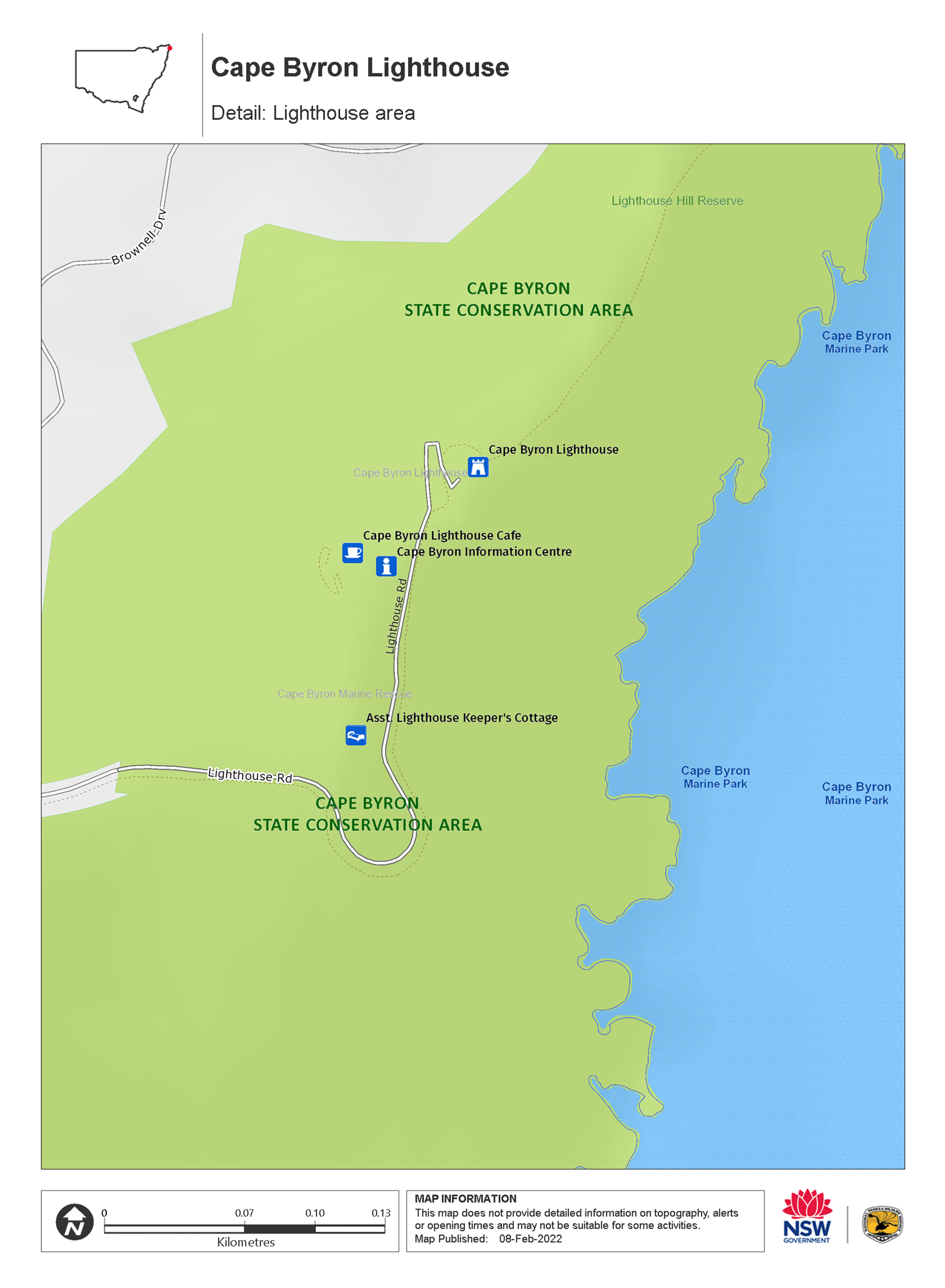
Map legend

Local alerts
For the latest updates on fires, closures and other alerts in this area, see https://www.nationalparks.nsw.gov.au/things-to-do/historic-buildings-places/cape-byron-lighthouse/local-alerts
General enquiries
- National Parks Contact Centre
- 7am to 7pm daily
- 1300 072 757 (13000 PARKS) for the cost of a local call within Australia excluding mobiles
- parks.info@environment.nsw.gov.au
Park info
- in Cape Byron State Conservation Area in the North Coast region
- Cape Byron State Conservation Area is open all hours, but may have to close at times due to poor weather or fire danger.
- Cape Byron Lighthouse lawn is open 8am to sunset.
- The Maritime Museum in the former Lighthouse Keeper’s office at the base of the lighthouse is open 10am to 4pm daily.
- Opening before 8am for events or disabled access can be arranged by prior notice – contact NPWS Byron Bay office during business hours 02 6639 8300.
-
Park entry fees:
Cape Byron Lighthouse lawn and Information Centre: $10 per vehicle per hour/$4 per hour motorcycles. Maximum 1 hour per vehicle per calendar day, including all NPWS annual passholders.
Captain Cook lookout, Cosy Corner, and The Pass: $5 per vehicle/motorcycle per hour. Tap and pay card or phone payments accepted at pay machines. Cash and credit cards accepted at Cape Byron Information Centre.
Coach entry: $30 per coach up to 30 seats; $57 per coach 31 to 43 seats; $94 per coach 44 seats and over.
Buy annual pass.
Visitor info
All the practical information you need to know about Cape Byron Lighthouse.
Getting there and parking
Cape Byron Lighthouse is 2km east of the Byron Bay town centre. To get there, take Lawson Street (which becomes Lighthouse Road) and follow it to the lighthouse.
Road quality
- Sealed roads
Vehicle access
- 2WD vehicles
Weather restrictions
- All weather
Parking
Parking is available at Cape Byron Lighthouse. It can be a busy place on the weekend, so parking might be limited.
Best times to visit
There are lots of great things waiting for you in Cape Byron State Conservation Area. Here are some of the highlights.
Spring
With the weather being a bit cooler, it's the perfect time of year for walking, barbecues and picnics on the beach.
Summer
Summer holidays beckon you – enjoy swimming, snorkelling, surfing, building sandcastles, or relaxing in the shade.
Winter
Cape Byron is a great spot to watch for whales on their annual migration - remember to take binoculars.
Weather, temperature and rainfall
Summer temperature
Average
22°C and 27°C
Highest recorded
35.1°C
Winter temperature
Average
15°C and 21°C
Lowest recorded
3.3°C
Rainfall
Wettest month
March
Driest month
September
The area’s highest recorded rainfall in one day
350.4mm
Facilities
Toilets
- Flush toilets
Carpark
Drinking water
Maps and downloads
Fees and passes
Park entry fees:
Cape Byron Lighthouse lawn and Information Centre: $10 per vehicle per hour/$4 per hour motorcycles. Maximum 1 hour per vehicle per calendar day, including all NPWS annual passholders.
Captain Cook lookout, Cosy Corner, and The Pass: $5 per vehicle/motorcycle per hour. Tap and pay card or phone payments accepted at pay machines. Cash and credit cards accepted at Cape Byron Information Centre.
Coach entry: $30 per coach up to 30 seats; $57 per coach 31 to 43 seats; $94 per coach 44 seats and over.
- All Parks Pass - For all parks in NSW (including Kosciuszko NP) $190 (1 year) / $335 (2 years)
- Multi Parks Pass - For all parks in NSW (except Kosciuszko) $65 (1 year) / $115 (2 years)
- Country Parks Pass - For all parks in Country NSW (except Kosciuszko) $45 (1 year) / $75 (2 years)
- Single Country Park Pass - For entry to a single park in country NSW (except Kosciuszko). $22 (1 year) / $40 (2 years)
Accessibility
Disability access level - no wheelchair access
Cape Byron Lighthouse is not accessible for people with mobility challenges due to steep stairs, however the area outside the lighthouse is flat.
Prohibited
Pets
Pets and domestic animals (other than certified assistance animals) are not permitted. Find out which regional parks allow dog walking and see the pets in parks policy for more information.
Smoking
NSW national parks are no smoking areas.
Visitor centre
-
Cape Byron Information Centre
199 Lighthouse Road, Byron Bay NSW 2481 - 9.30am to 4.30pm daily. Closed Christmas Day
- 02 6639 8300
Learn more
Cape Byron Lighthouse is in Cape Byron State Conservation Area. Here are just some of the reasons why this park is special:
Cape Byron Lighthouse
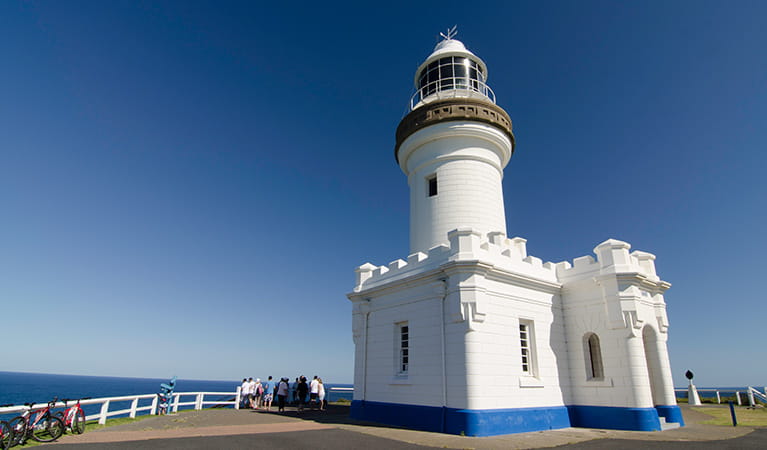
Perched high above Byron Bay's glorious coastline, historic Cape Byron lighthouse was constructed on this rugged headland in 1901. Its landmark 22m high white tower houses the light that still illuminates the bay of an evening. To find out more about the lighthouse take a tour with an expert guide and be sure to check out the Maritime Museum. In days gone by, lighthouse keepers were responsible for igniting the lighthouse's light of an evening. The keepers have long been replaced by automated light systems; however the Victorian Georgian style cottages in which they lived remain as heritage listed buildings. Today they operate as holiday accommodation, having been carefully restored to offer modern convenience while retaining their historical charm and an insight into the life of a lighthouse keeper.
- Cape Byron Information Centre Cape Byron Information Centre is the place to find visitor information for Cape Byron State Conservation Area, Cape Byron Marine Park and surrounding national parks in the Byron Bay area.
- Cape Byron Lighthouse: A special place Experience a bird’s eye view from the top of the iconic Cape Byron Lighthouse in this Early Stage 1 (Kindergarten) Geography excursion. Students will learn about the features of this special place and its significance to people and the community.
- Cape Byron Lighthouse: A special place Experience a bird’s eye view from the top of the iconic Cape Byron Lighthouse in this Stage 1 (Years 1-2) geography excursion. Students will learn about the features of the lighthouse and its significance to people and the community.
Keepers of Country
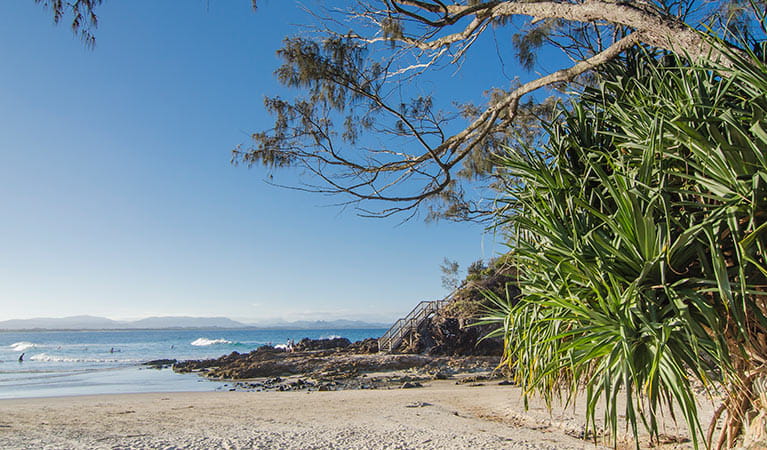
Walgun, as Cape Byron is known by its traditional custodians, maintains spiritual, cultural and historical importance for the Bundjalung of Byron Bay (Arakwal) Aboriginal People. The pipi midden (shell mound) at The Pass is one of the largest and oldest in far north NSW.
- Dolphin Dreaming Dolphin Dreaming is an Early Stage 1 (Kindergarten) school excursion in Cape Byron State Conservation Area, focusing on Geography. Through story, dance and creative expression, Arakwal Aboriginal guides present the life and culture of Byron Bay's Aboriginal people.
- Dolphin Dreaming Dolphin Dreaming is a Stage 1 (Years 1-2) school excursion in Cape Byron State Conservation Area, focusing on Geography. Through story, dance and creative expression, Arakwal Aboriginal guides present the life and culture of Byron Bay's Aboriginal people.
- Dolphin Dreaming Dolphin Dreaming is a Stage 3 (Years 5-6) school excursion in Cape Byron State Conservation Area, focusing on Geography. Through story, dance and creative expression, Arakwal Aboriginal guides present the life and culture of Byron Bay's Aboriginal people.
- Dolphin Dreaming Dolphin Dreaming is a Stage 2 (Years 3-4) school excursion in Cape Byron State Conservation Area, focusing on Geography outcomes. Through story, dance and creative expression, Arakwal Aboriginal guides present the life and culture of Byron Bay's Aboriginal people.
- Palm Valley Palm Valley, or ‘The Pass,’ offers well-equipped picnic areas right by the beach, plus a popular café, several walking tracks, and access to the Fishermans lookout.
View from the top
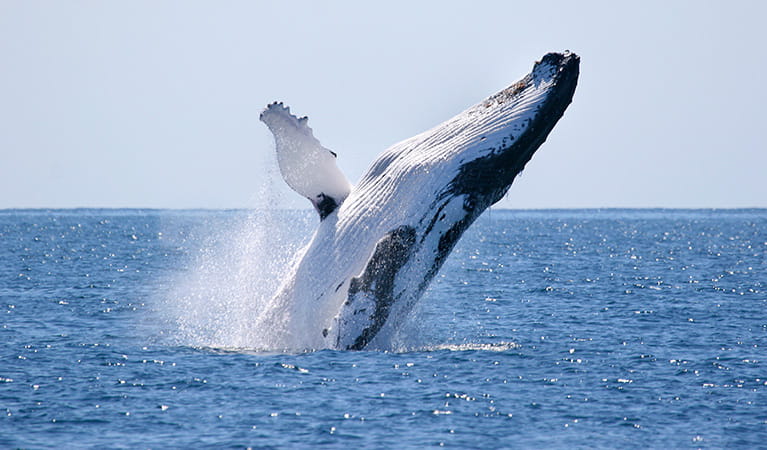
Cape Byron State Conservation Area is part of a significant north-to-south regional corridor for migratory animals, including the fruit dove and cuckoo shrike. Locals you might be lucky enough to spot while touring the area include threatened wallabies and sea eagles. A peaceful walk through the area’s serene littoral rainforest, with plant life; such as laurel trees, white lace flowers and basket ferns, to admire along the way, is sure to further enrich your experience of the Cape Byron area.
- A whale of a time Discover the wonderful world of whales on this Stage 2 (Years 3-4) excursion around Cape Byron headland. This excursion is designed to support the Living World Science and Technology topic content strand.
- Byron tandem hang gliding flights and lessons Try the thrilling sport of hang gliding with a tandem flight over spectacular Cape Byron or nearby Lennox Head. With 40 years’ experience, Byron Airwaves Hang Gliding School is your ticket to the freedom of flight.
- Cape Byron walking track Enjoy spectacular coastal views along the Cape Byron walking track that takes you on a hike through rainforest, beach, grassland and clifftops to the lighthouse.
- Cape Byron: The earth’s environment Join us on an Earth’s environment Geography excursion at beautiful Cape Byron for Stage 2 (Years 3-4) students. Students will explore the features of the reserve and learn about people’s differing perceptions of the park and how it is managed.
- Wategos Beach Located just north west of Cape Byron and the lighthouse, Wategos Beach is one of Byron’s best places to picnic, paddle and play.
Plants and animals protected in this park
Animals
-
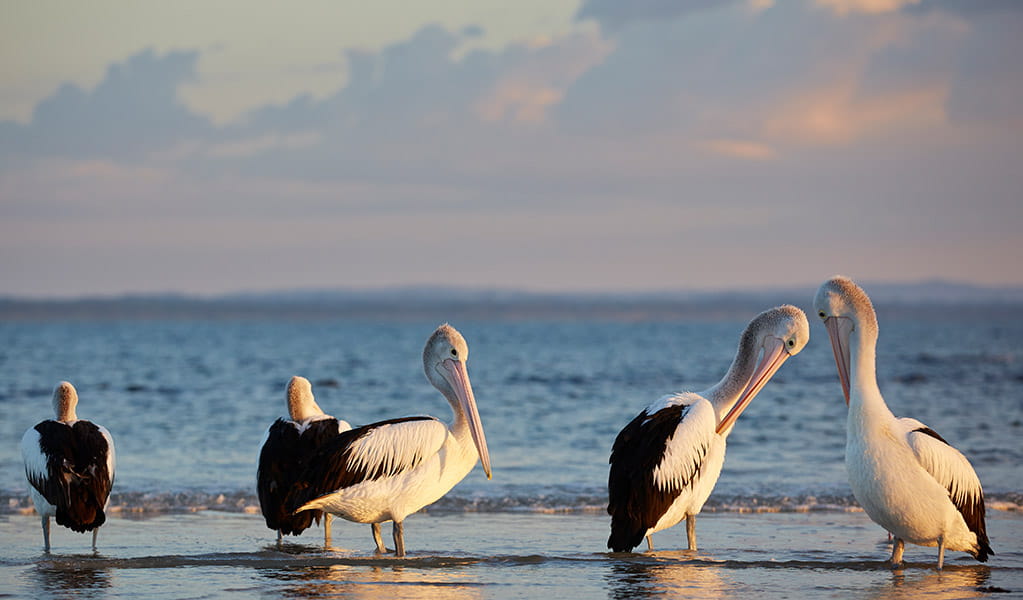
Australian pelican (Pelecanus conspicillatus)
The curious pelican is Australia’s largest flying bird and has the longest bill of any bird in the world. These Australian birds are found throughout Australian waterways and the pelican uses its throat pouch to trawl for fish. Pelicans breed all year round, congregating in large colonies on secluded beaches and islands.
-
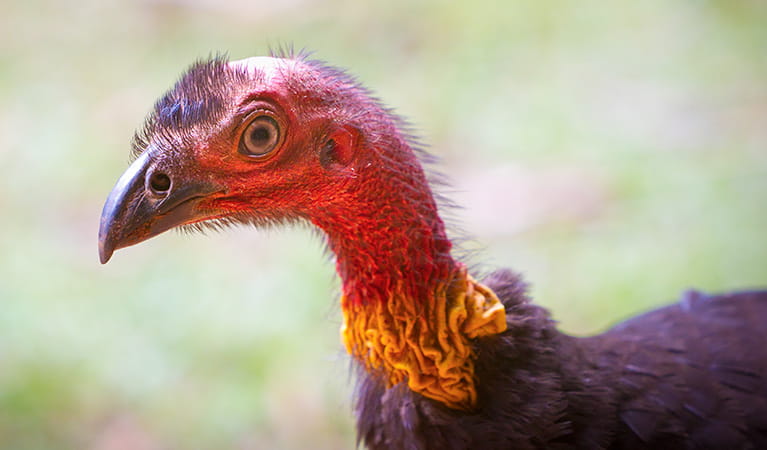
Australian brush turkey (Alectura lathami)
The Australian brush turkey, also known as bush or scrub turkey, can be found in rainforests along eastern NSW. With a striking red head, blue-black plumage and booming call, these distinctive Australian birds are easy to spot while bird watching in several NSW national parks.
-
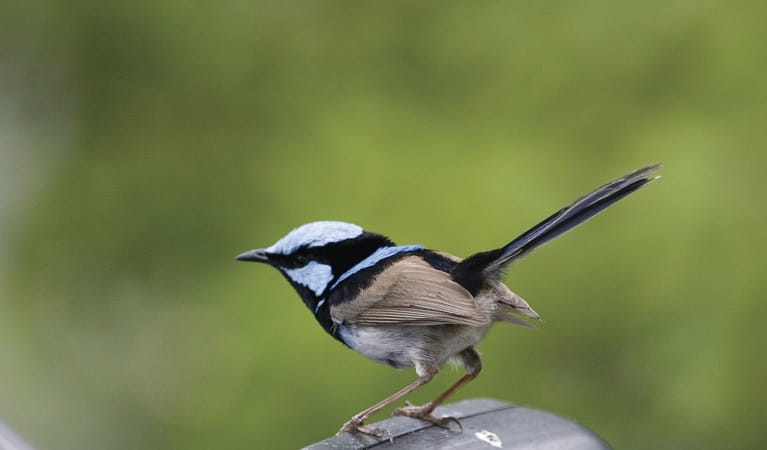
Superb fairy wren (Malurus cyaneus)
The striking blue and black plumage of the adult male superb fairy wren makes for colourful bird watching across south-eastern Australia. The sociable superb fairy wrens, or blue wrens, are Australian birds living in groups consisting of a dominant male, mouse-brown female ‘jenny wrens’ and several tawny-brown juveniles.
Plants
-
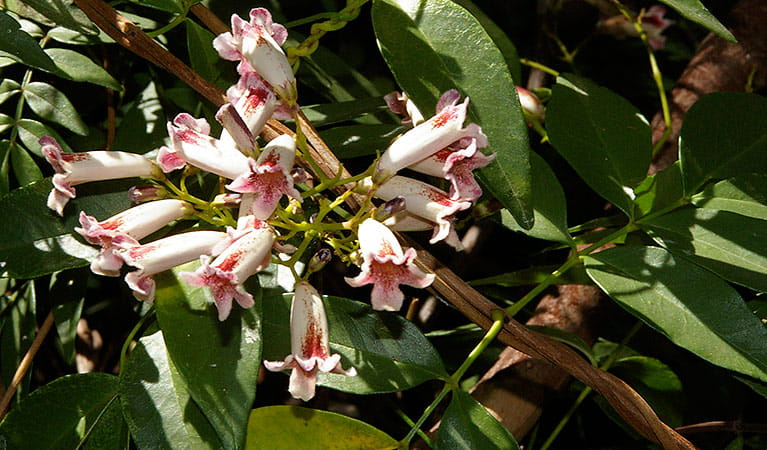
Wonga wonga vine (Pandorea pandorana)
The wonga wonga vine is a widespread vigorous climber usually found along eastern Australia. A variation of the plant occurs in the central desert, where it resembles a sprawling shrub. One of the more common Australian native plants, the wonga wonga vine produces bell-shaped white or yellow flowers in the spring, followed by a large oblong-shaped seed pod.
-
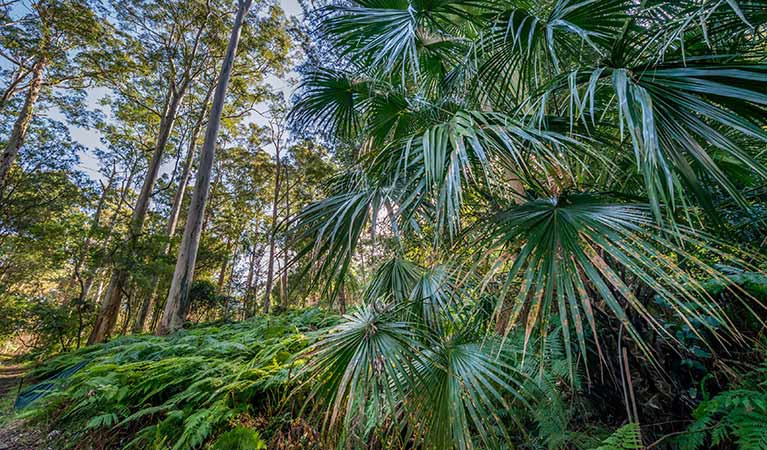
Cabbage palm (Livistona australis)
With glossy green leaves spanning 3-4m in length and a trunk reaching a height of up to 30m, the cabbage tree palm, or fan palm, is one of the tallest Australian native plants. Thriving in rainforest margins along the east coast of NSW, in summer this giant palm produces striking spikes of cream flowers which resemble cabbages.
Environments in this park
Education resources (1)
School excursions (11)
- A whale of a time, Stage 2 (Years 3-4), Science and Technology
- Cape Byron: Environmental change and management, Stage 5 (Years 9-10), Geography
- Cape Byron: The earth’s environment, Stage 2 (Years 3-4), Geography
- Dolphin Dreaming, Early Stage 1 (Kindergarten), Geography
- Dolphin Dreaming, Stage 1 (Years 1-2), Geography
- Cape Byron Lighthouse: A special place, Early Stage 1 (Kindergarten), Geography
- Dolphin Dreaming, Stage 3 (Years 5-6), Geography
- Dolphin Dreaming, Stage 2 (Years 3-4), Geography
- Whale secrets, Early Stage 1 (Kindergarten), Science and Technology
- Whale secrets, Stage 1 (Years 1-2), Science and Technology
- Cape Byron Lighthouse: A special place, Stage 1 (Years 1-2), Geography

